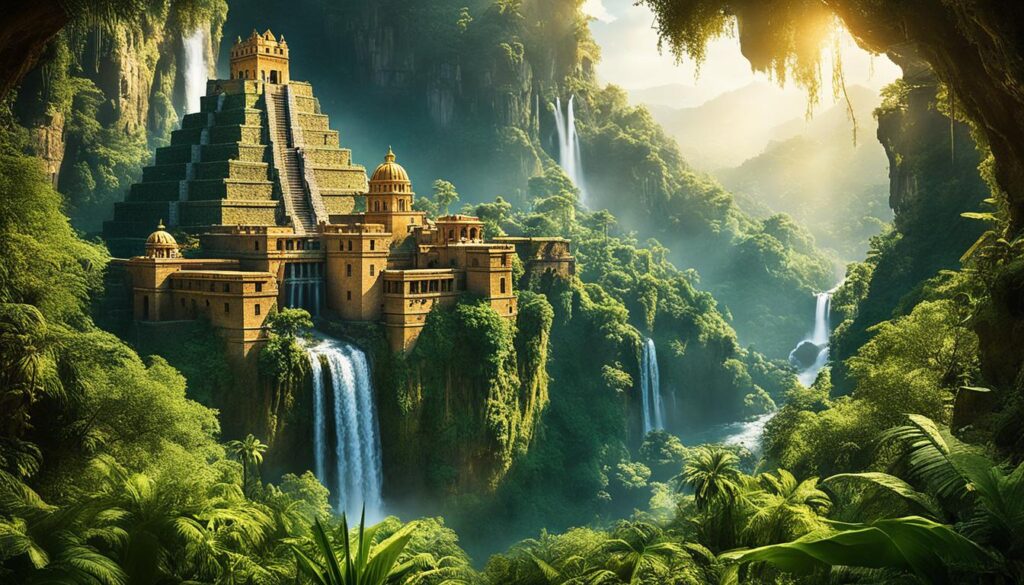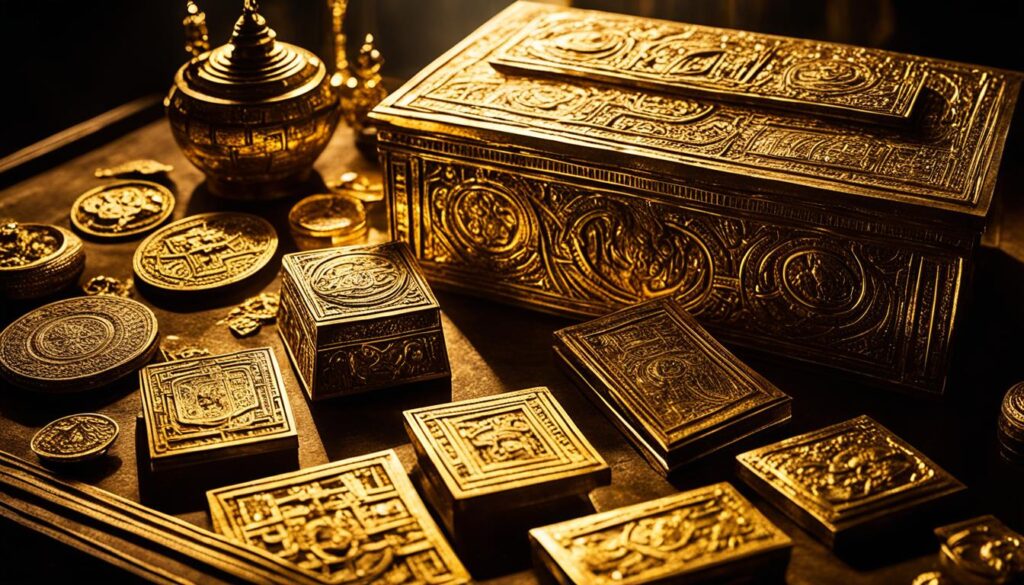For centuries, the legend of El Dorado has thrilled adventurers, explorers, and historians. This tale of a land full of gold has crossed cultures and continents. It has left a lasting mark on humanity.
The name El Dorado means “the gilded one” in Spanish. It started in South America before the Spanish arrived. The Spanish conquistadors wanted to find this city, leading to many famous expeditions.
We will look into how the El Dorado legend began and changed over time. We’ll also explore the mysteries and debates around it. From the conquistadors’ quests to today’s archaeological finds, El Dorado’s story still inspires and fascinates us.
The Myth of El Dorado
The story of El Dorado, known as the “City of Gold,” has fascinated people worldwide for centuries. It started with pre-Columbian civilizations in the Andes of South America. The Muisca people of today’s Colombia were key in creating this lasting myth.
Origins and Origins of the El Dorado Legend
The El Dorado legend comes from the Muisca’s culture and beliefs. They were a sophisticated pre-Columbian group who loved gold. They crowned a new leader, the “El Dorado” or “The Gilded One,” every year.
This leader would cover himself in gold dust and jump into the sacred Lake Guatavita. This act was for the gods. The Muisca’s wealth of gold and this ritual sparked tales of a lost city of gold. This caught the eye of European explorers.
Cultural Significance in Pre-Columbian America
Gold was very important to the Muisca and other Andean civilizations. It was used in rituals and as decoration. They saw gold as a sacred material, linked to the divine.
The Muisca leaders, seen as powerful by the gods, used gold to connect with the spiritual world. This deep respect for gold helped create the El Dorado myth. It became a symbol of the area’s culture and spirituality.
Historical Curiosities
The story of El Dorado has always caught the eye of explorers, adventurers, and historians. This city of gold, full of mystery, has been a big dream for many. It has changed from ancient myths to today’s quests, pushing people to find its truth.
The myth of El Dorado comes from pre-Columbian America’s rich culture. Legends tell of a golden ruler and a city full of wealth. These stories made many explorers go to South America, hoping to find something new and exciting.

Many expeditions have searched for El Dorado over the years. From the 16th-century conquistadors to today’s adventurers, each one has added to the mystery. Their stories and discoveries are now part of history.
The legend of El Dorado still grabs our attention, inspiring artists and scholars. It shows our deep desire for adventure and the power of legends. By exploring this story, we learn about human nature and the past.
Conquistadors in Search of El Dorado
The promise of untold riches and glory drove many Spanish conquistadors to search for the legendary El Dorado. They were fueled by their thirst for exploration and the chase for wealth. These brave explorers ventured into the unknown lands of the New World, eager to find the secrets of the fabled “City of Gold.”
Ambitious Expeditions and Their Leaders
Several notable conquistadors led these conquests, each with their own story and legacy. Gonzalo Pizarro, a famous explorer, led a perilous journey to find the mythical land of cinnamon. This land was thought to be linked to El Dorado. His expedition faced many hardships but is now famous in Spanish exploration history.
Diego de Ordaz was another key figure in the quest for El Dorado. He had helped Hernán Cortés conquer the Aztec Empire before. Ordaz’s expedition aimed to explore the Amazon basin and find El Dorado’s secrets. The journey was tough, facing harsh terrain, hostile tribes, and disease.
Pedro de Ursúa also made a mark in the search for El Dorado. He led an expedition down the Amazon River to reach the fabled city. But his journey was hit by mutiny and the murder of the leader. This shows the huge challenges and dangers of seeking El Dorado.
These expeditions, led by famous conquistadors, showed how far the Spanish would go for El Dorado. Their stories, filled with both success and tragedy, are key to the quest for the City of Gold’s legacy.
Fact or Fiction: Separating Truth from Lore
The story of El Dorado has fascinated people for centuries. It’s hard to tell what’s real and what’s just a myth. Over time, the truth and the legend have mixed together.
Many thought El Dorado was just a fairy tale, but new discoveries have made us rethink. Archaeologists have found clues that suggest it might have been real. These findings have made people curious about the truth behind the legend.
Historians are looking into the El Dorado legend to understand its roots. They study the culture of pre-Columbian America. They want to know how the indigenous people saw El Dorado. By looking at old records and artifacts, they hope to clear up the confusion.
The search for El Dorado is still on, and it’s hard to say what’s true and what’s not. But, the more we explore, the more we might find out. It’s possible that El Dorado was more than just a myth. It could be a piece of a rich and interesting history.
The Lost City of Gold: Archaeological Evidence
The search for El Dorado, a mythical lost city of gold, has thrilled explorers and historians for ages. Despite not knowing where it is, archaeology has found clues and artifacts. These keep the mystery alive.
Clues and Artifacts Fueling the Mystery
The site of Lake Guatavita in Colombia is key to finding El Dorado. This lake was thought to be where the golden city was. It has given up many golden artifacts and relics from the Muisca culture.
The Muisca people, who lived there, believed in El Dorado. Archaeologists have found golden masks, jewelry, and religious items. These items show us the culture and beliefs of the Muisca.

Other sites in the Andes have also shown the Muisca’s skills in metalwork and engineering. They found big irrigation systems, complex buildings, and other advanced technology. This has made people even more curious about finding El Dorado.
Even though we don’t know where El Dorado is, archaeology has given us a lot of information. It tells us about the culture and history of the legend. As researchers find more clues, the mystery of the lost city of gold grows. It keeps fascinating people all over the world.
El Dorado’s Influence on Pop Culture
The lost city of El Dorado has fascinated people for centuries. Its impact is seen in popular culture, from books to movies and video games. The idea of a golden city has inspired many stories and tales.
Authors like Sir Arthur Conan Doyle and H. Rider Haggard have used El Dorado in their stories. Doyle’s “The Lost World” and Haggard’s “She” highlight the quest for the city. These books show how the search for El Dorado drives adventure.
Hollywood has also been drawn to El Dorado’s story. The 2000 animated movie “The Road to El Dorado” mixes comedy and adventure. The 2019 film “Dora and the Lost City of Gold” brings the legend to life through Dora from Nickelodeon.
Video games often draw inspiration from El Dorado. The “Uncharted” series and “Tomb Raider” franchise feature the lost city in their stories. These games blend cinematic storytelling with exploration.
El Dorado’s legend reaches beyond movies and games. It appears in TV shows and comic books too. Its lasting charm lies in the promise of hidden riches and the mystery it holds. This has made it a favorite among audiences and creators alike.
Modern-Day Explorers Seeking El Dorado
The legend of El Dorado, a city of gold, still excites today’s explorers and researchers. In the 20th century, new tech helped a new group of adventurers find clues. They aimed to solve the mystery of this lost city.
Expeditions and Discoveries in the 20th Century
In the early 1900s, explorers started searching for El Dorado again. They went into the jungles and far-off places in South America. They used better maps, GPS, and planes to look for the city of gold.
Hiram Bingham led a famous expedition in 1911. He found the Inca citadel of Machu Picchu in Peru. Machu Picchu wasn’t El Dorado, but it made people want to find more lost cities.
After that, many expeditions looked for the truth about El Dorado. They were funded by private and government groups. New tech like aerial photos and satellite images helped them search the Amazon and other hard-to-reach places for signs of the lost city.
Even though they haven’t found El Dorado, these 20th-century expeditions learned a lot. They found out about the cultural and historical importance of the legend. This has given us a new view of the myths and legends that have been around for centuries.
El Dorado’s Legacy and Enduring Allure
The story of El Dorado has amazed people for over 400 years. It started in pre-Columbian America and has become a symbol of culture and history. Even though finding the “City of Gold” is hard, its story still drives exploration, research, and art worldwide.
El Dorado’s charm lies in its promise of endless wealth and the dream of discovery. It has made explorers, conquistadors, and adventurers dream for centuries. Their quests have changed history forever.
Today, El Dorado still inspires artists, writers, and filmmakers. They use the legend in many creative works. From books and movies to music and art, El Dorado’s story touches people everywhere.
As we learn more about El Dorado, its impact grows. It shows how myths can capture and inspire us. It’s a reminder of our endless curiosity and the power of stories to move us.
Lessons from the Legend of El Dorado
The story of El Dorado teaches us many valuable lessons. It’s a tale of the dangers of ambition and greed. It shows us the risks of chasing after something without thinking it through.
One key lesson is the need for caution in our quests. The Spanish conquistadors, like Gonzalo Pizarro and Francisco de Orellana, wanted gold so badly. But their pursuit ended in disaster, showing us to be careful and respectful when exploring new things.
El Dorado also warns us about the dangers of being too greedy. The desire for gold led to harm for many people and cultures. It teaches us to value deeper things and to be humble when facing the unknown.






